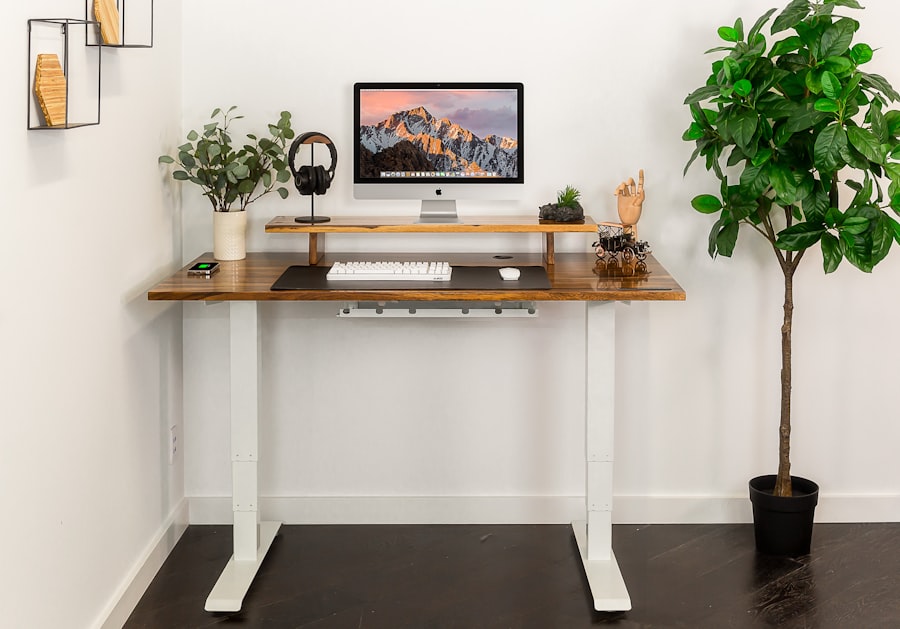In the modern workplace, where many individuals spend hours seated at desks, the significance of a comfortable office chair cannot be overstated. A well-designed chair not only enhances productivity but also plays a crucial role in maintaining overall health. Prolonged periods of sitting can lead to a myriad of health issues, including back pain, poor circulation, and even long-term musculoskeletal disorders.
A comfortable office chair serves as the first line of defense against these ailments, providing the necessary support to keep the body aligned and reduce strain on muscles and joints. Moreover, the psychological impact of a comfortable chair should not be overlooked. When employees feel physically comfortable, they are more likely to experience higher levels of job satisfaction and engagement.
A supportive chair can create an environment conducive to focus and creativity, allowing individuals to immerse themselves in their work without the distraction of discomfort. In contrast, an uncomfortable chair can lead to frequent breaks, decreased concentration, and ultimately lower productivity. Therefore, investing in a quality office chair is not merely a matter of comfort; it is an investment in employee well-being and organizational efficiency.
Key Takeaways
- A comfortable office chair is essential for maintaining good posture and preventing back pain.
- When choosing an office chair, consider factors such as adjustable height, lumbar support, and seat depth.
- Look for ergonomic features in an office chair, such as adjustable armrests, tilt mechanism, and breathable fabric.
- Adjust your office chair to ensure proper alignment of your body and maximum comfort while working.
- Proper posture and support are crucial when using an office chair to prevent strain and discomfort.
Choosing the Right Office Chair for Your Needs
Work Style and Task Requirements
The type of work being performed is a primary consideration when choosing an office chair. For example, someone who spends their day engaged in tasks that require extensive computer use may benefit from a chair that offers excellent lumbar support and adjustable features.
Chair Size and Fit
The chair’s size and fit are critical aspects to consider. An office chair should accommodate the user’s body dimensions to ensure proper support and comfort. This includes evaluating seat height, depth, and width, as well as backrest height and angle. A chair that is too large or too small can lead to discomfort and hinder productivity.
Workspace Environment and Personal Preferences
Individuals should also consider their workspace environment and personal preferences when selecting an office chair. For instance, a compact chair may be more suitable for a small home office, while a larger executive chair might be appropriate for a spacious corporate setting. Ultimately, understanding personal preferences and work requirements is essential in making an informed choice.
Ergonomic Features to Look for in an Office Chair

When searching for an office chair, ergonomic features are paramount in ensuring comfort and support during long hours of sitting. One of the most critical ergonomic elements is lumbar support, which helps maintain the natural curve of the spine. Chairs with adjustable lumbar support allow users to customize the height and firmness to suit their specific needs, reducing the risk of lower back pain.
Another important feature is seat height adjustment. A chair that can be easily adjusted allows users to align their feet flat on the floor while keeping their knees at a 90-degree angle. This positioning promotes healthy circulation and reduces pressure on the thighs.
Additionally, seat depth adjustment is beneficial for accommodating different leg lengths; it ensures that users can sit back comfortably against the backrest while leaving adequate space between the back of the knees and the seat edge. Armrests are also a significant consideration in ergonomic design. Adjustable armrests can help alleviate shoulder strain by allowing users to rest their arms comfortably while typing or using a mouse.
Furthermore, a swivel base enhances mobility, enabling users to reach different areas of their workspace without straining or twisting their bodies. These ergonomic features collectively contribute to a healthier sitting experience and can significantly impact overall well-being.
Adjusting Your Office Chair for Maximum Comfort
Once you have selected an office chair with suitable ergonomic features, proper adjustment is essential for maximizing comfort and support. The first step is to adjust the seat height so that your feet rest flat on the floor or on a footrest, with your knees positioned slightly below hip level. This alignment helps maintain proper circulation and reduces pressure on the lower back.
Next, focus on adjusting the lumbar support. The lumbar region should be supported in its natural curve; this may require moving the lumbar support up or down or adjusting its firmness. It is crucial to sit back against the backrest while making these adjustments to ensure that you are receiving adequate support where it is needed most.
The armrests should also be adjusted to allow your arms to rest comfortably without raising your shoulders. Ideally, your elbows should be at a 90-degree angle when your hands are on your keyboard or desk surface. Finally, take time to adjust the backrest angle; it should provide support while allowing you to lean back slightly without losing contact with the backrest.
Regularly reassessing these adjustments throughout your workday can help maintain comfort as your body may shift during prolonged sitting.
Proper Posture and Support with an Office Chair
Maintaining proper posture while seated in an office chair is vital for preventing discomfort and long-term health issues. Good posture involves sitting up straight with your shoulders relaxed but not slouched. Your back should be fully supported by the chair’s backrest, which should encourage an upright position without forcing you into it.
The positioning of your computer screen also plays a significant role in maintaining proper posture. The top of your monitor should be at or just below eye level, allowing you to look straight ahead rather than tilting your head up or down. This alignment helps prevent neck strain and encourages a more natural sitting position.
Additionally, it is essential to take regular breaks from sitting to promote circulation and reduce muscle fatigue. Standing up, stretching, or walking around for a few minutes every hour can significantly enhance comfort levels and overall well-being. Incorporating these practices into your daily routine can help reinforce good posture habits while using an office chair.
Stylish and Functional Office Chair Options

Mid-Century Modern Chairs: A Perfect Blend of Style and Function
Mid-century modern chairs are a great example of this trend. They often feature sleek lines, vibrant colors, and contoured seats that provide essential support. Additionally, they come with adjustable heights, ensuring that users can find their perfect position.
Mesh Office Chairs: Breathability and Style
Mesh office chairs are another popular option that combines style with breathability. Designed with a woven fabric, these chairs allow for air circulation, keeping users cool during long hours of work. They often come with adjustable lumbar support and armrests, making them both functional and fashionable.
Executive Chairs: Elegance and Comfort
For those who prefer a more traditional look, executive chairs made from high-quality leather or faux leather offer elegance alongside comfort. These chairs typically feature plush cushioning and high backs that provide ample support for extended periods of sitting. With various colors and finishes available, it is possible to find an executive chair that complements any office decor while ensuring maximum comfort.
Budget-Friendly Office Chair Options
While investing in a quality office chair is essential for comfort and health, budget constraints can often pose challenges. Fortunately, there are numerous budget-friendly options available that do not compromise on essential features. Many manufacturers offer ergonomic chairs at lower price points that still provide adjustable heights, lumbar support, and basic cushioning.
For example, several brands produce mesh chairs that are both affordable and functional. These chairs often come equipped with adjustable features such as seat height and armrests while maintaining a lightweight design that makes them easy to move around the office. Additionally, some budget-friendly options include task chairs designed for versatility; they typically feature simple designs that fit well in various work environments.
Another cost-effective solution is purchasing used or refurbished office chairs from reputable sources. Many businesses upgrade their furniture regularly, leading to high-quality chairs being available at significantly reduced prices. When considering used options, it is essential to inspect the chair for wear and tear while ensuring that all adjustable features function correctly.
Maintaining and Caring for Your Office Chair
Proper maintenance of an office chair extends its lifespan and ensures continued comfort over time. Regular cleaning is essential; depending on the material—be it fabric, leather, or mesh—different cleaning methods may be required. For fabric chairs, vacuuming regularly can help remove dust and debris, while spot cleaning with appropriate cleaners can address stains without damaging the fabric.
For leather chairs, using a damp cloth followed by a leather conditioner can keep the material supple and prevent cracking over time. Mesh chairs may require gentle wiping with a soft cloth to maintain their appearance without compromising breathability. Additionally, periodically checking all adjustable components is crucial for ensuring optimal functionality.
Tightening screws or bolts as needed can prevent wobbling or instability while using the chair. If any parts become damaged or worn out over time, seeking replacement parts from manufacturers can help restore the chair’s original comfort level. By investing time in maintaining an office chair properly, users can enjoy its benefits for years to come while promoting a healthier work environment overall.
If you’re looking to maximize comfort in your office space, consider investing in ergonomic furniture. According to a recent article on officeinterior.ae, ergonomic chairs and desks are designed to support your body and reduce strain, ultimately leading to increased productivity and overall well-being. Pairing a comfortable chair with a straight desk, as discussed in another article on the site (source), can create a workspace that promotes both comfort and efficiency.
FAQs
What are the key features of a comfortable office chair?
A comfortable office chair should have adjustable seat height, lumbar support, armrests, and a reclining feature. It should also have a cushioned seat and breathable fabric to provide comfort for long hours of sitting.
Why is it important to have a comfortable office chair?
Having a comfortable office chair is important for maintaining good posture, reducing the risk of back and neck pain, and increasing productivity. It also promotes overall well-being and comfort during long hours of work.
What are the benefits of using a comfortable office chair?
Using a comfortable office chair can improve posture, reduce the risk of musculoskeletal disorders, increase productivity, and enhance overall comfort and well-being during long hours of sitting.
How do you choose the right comfortable office chair?
When choosing a comfortable office chair, consider factors such as adjustable features, lumbar support, cushioning, and breathability. It’s important to test the chair for comfort and support before making a purchase.
How can you maintain a comfortable office chair?
To maintain a comfortable office chair, regularly clean and dust the chair, check for any loose or damaged parts, and adjust the settings to ensure proper support and comfort. It’s also important to follow the manufacturer’s guidelines for maintenance.


